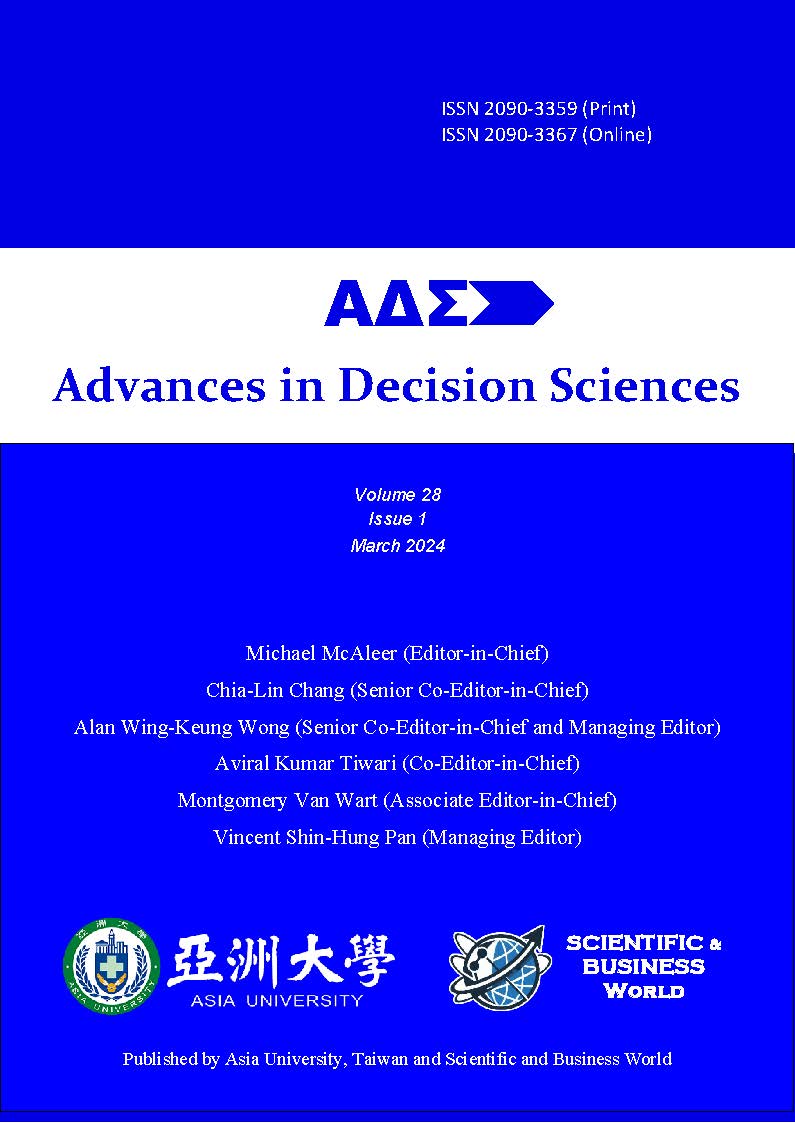Examining the Impacts of the Pandemic on the Housing Bubble in Hong Kong
DOI:
https://doi.org/10.47654/v28y2024i1p27-46Keywords:
Housing bubble, Right-tailed ADF test, COVID-19 pandemic, DevelopersAbstract
Purpose: The COVID-19 pandemic has significantly disrupted the housing market in Hong Kong and created economic uncertainty and job losses. Therefore, this study aims to revisit the current housing bubble in Hong Kong and to check whether the pandemic is a shock that led to the burst of the housing bubble. The insights derived from this study are crucial for shaping future housing policies in response to such economic events.
Design/methodology/approach: This study utilizes four bubble testing techniques of right-tailed Augmented Dickey-Fuller (ADF) tests to examine the presence of a housing bubble and determine its starting and ending dates.
Findings: The findings reveal that COVID-19 triggered a significant negative shock to the housing market, leading to a bubble burst during the pandemic. Additionally, the analysis indicates a rise in negative equity cases following the burst, largely due to reliance on highly leveraged mortgage loans.
Originality/value: The novelty of this study lies in its use of inflation-adjusted real housing prices to detect the housing bubble. Furthermore, developers could use our findings to improve their selling strategies during the housing market downturn, which, in turn, adds valuable insights to the housing and financial literature.
Practical implications: This study highlights the financial risks associated with the burst of housing bubbles and provides valuable policy recommendations for stabilizing the housing market. The findings emphasize that financial institutions should reduce the credit risks linked to mortgage loan portfolios before negative equity cases increase. The study offers professionals in the housing and finance sectors insight into risk management strategies.
References
Abraham, J., & Hendershott, O. (1996). Bubbles in Metropolitan Housing Markets. Journal of Housing Research, 7(2), 191-207.
Allen, D., & McAleer, M. (2021). Predicting COVID-19 Cases and Deaths in the USA from Tests and State Populations. Advances in Decision Sciences, 25(2), 1-27.
Andre, C., Caraiani, P., Calin, A. C., & Gupta, R. (2022). Can Monetary Policy Lean Against Housing Bubbles? Economic Modelling, 110, 105801.
Anundsen, A. K., Gerdrup, K., Hansen, F., & Kragh-Sorensen, K. (2016). Bubbles and Crises: The Roles of House Prices and Credit. Journal of Applied Econometrics, 31, 1291-1311.
Anundsen, A. K., Kivedal, B. K., Larsen, E. R., & Thorsrud, L. A. (2023). Behavioral Changes in the Housing Market Before and After the COVID-19. Journal of Housing Economics, 59.
Bai, Z., Hui, Y. C., & Wong, W. K. (2015). Internet Bubble Examination with Mean-Variance Ratio. Handbook of Financial Econometrics and Statistics, 1451-1465.
Bangura, M., & Lee, C. L. (2020). Housing Price Bubbles in Greater Sydney: Evidence from a Submarket Analysis. Housing Studies, 37(1), 1-36.
Barberis, N., Greenwood, R., Jin, L., & Shleifer, A. (2018). Extrapolation and Bubbles. Journal of Financial Economics, 129(2), 203-227.
Bourdeau-Brien, M., & Kryzanowski, L. (2020). Natural Disasters and Risk Aversion. Journal of Economic Behavior and Organization, 177, 818-835.
Brown, P., Daigneault, A. J., Tiernstrom, E., & Zou, W. (2018). Natural Disasters, Social Protection, and Risk Perceptions. World Development, 104, 310-325.
Case, K. E., & Shiller, R. J. (2003). Is There a Bubble in the Housing Market? Brookings Papers on Economic Activity, 2, 299-362.
Chan, A. K. W., Cheung, L. T., Chong, E. K. M., Lee, M. Y. K., & Wong, M. Y. (2022). Hong Kong’s New Wave of Migration: Socio-Political Factors of Individuals’ Intention to Emigrate. Comparative Migration Studies, 10(1), 49.
Chong, T. T. L., Li, X., & Yip, C. (2020). The Impact of COVID-19 on ASEAN. Economic and Political Studies, 166-185.
Cox, W. (2023). Demographia International Housing Affordability. Available at: http://www.demographia.com/dhi.pdf
Deng, Y., Han, C., Li, T., & Wang, Y. (2024). The Effectiveness and Consequences of the Government’s Interventions for Hong Kong’s Residential Housing Markets. Real Estate Economics.
Ding, H., Fan, H., & Lin, S. (2022). COVID-19, Firm Exposure and Firm Value: A Tale of Two Lockdowns. China Economic Review, 71.
Fama, E. F. (1965). The Behavior of Stock-Market Prices. Journal of Business, 38(1), 34-105.
Farmer, R. E. A. (2015). The Stock Market Crash Did Cause the Great Recession. Oxford Bulletin of Economics and Statistics, 77(5), 617-633.
Finance Chiefs Ease Negative Equity Fears. (2023, November 23). The Standard.
Foote, C. L., Gerardi, K., & Willen, P. S. (2008). Negative Equity and Foreclosure: Theory and Evidence. Journal of Urban Economics, 64(2), 234-245.
Foroni, C., Marcellino, M., & Stevanovic, D. (2020). Forecasting the COVID-19 Recession and Recovery: Lessons from the Financial Crisis. ECB Working Paper Series, No. 2468.
Garber, P. M. (2000). Famous First Bubbles: The Fundamentals of Early Manias. Cambridge: MIT Press.
Gharib, C., Mefteh-Wali, S., & Jabeur, S. B. (2021). The Bubble Contagion Effect of COVID-19 Outbreak: Evidence from Crude Oil and Gold Markets. Finance Research Letters, 38, 101703.
Glaeser, E. L., & Nathanson, C. G. (2015). Housing Bubbles. Handbook of Regional and Urban Economics, 5, 701-751.
Gyourko, J., & Molloy, R. (2015). Regulation and Housing Supply. Handbook of Regional and Urban Economics, 5, 1289-1337.
Homm, U., & Breitung, J. (2012). Testing for Speculative Bubbles in Stock Market: A Comparison of Alternative Methods. Journal of Financial Econometrics, 10(1), 198-231.
Hong Kong’s Population Drops for 3rd Straight Year, While City Posts Net Outflow of 60,000 Residents in 2022. (2023, February 16). South China Morning Post.
Hui, E. C. H., Liang, C., Wang, Z., Song, B., & Gu, Q. (2012). Real Estate Bubbles in China: A Tale of Two Cities. Construction Management and Economics, 30, 951-961.
Ji, X., Bu, N., Zheng, C., Xiao, H., Liu, C., Chen, X., & Wang, K. (2022). Stock Market Reaction to the COVID-19 Pandemic: An Event Study. Portuguese Economic Journal, 25, 1-20.
Jorda, O., Schularick, M., & Taylor, A. M. (2016). The Great Mortgaging: Housing Finance, Crises, and Business Cycles. Economic Policy, 31(85), 107-152.
Kung, J. J., & Wong, W. K. (2009). Profitability of Technical Analysis in the Singapore Stock Market Before and After the Asian Financial Crisis. Journal of Economic Integration, 24(1), 135-150.
Lai, R. N., & Van Order, R. A. (2020). A Tale of Two Countries: Comparing the US and Chinese Housing Markets. Journal of Real Estate Finance and Economics, 61(3), 505-547.
Lam, K., Liu, T., & Wong, W. K. (2012). A New Pseudo-Bayesian Model with Implications for Financial Anomalies and Investors’ Behavior. Journal of Behavioral Finance, 13(2), 93-107.
Lean, H. H., McAleer, M., & Wong, W. K. (2015). Preferences of Risk-Averse and Risk-Seeking Investors for Oil Spot and Futures Before, During and After the Global Financial Crisis. International Review of Economics and Finance, 40, 204-216.
Leung, C. K. Y., Leong, Y. C. F., & Wong, S. K. (2006). Housing Price Dispersion: An Empirical Investigation. Journal of Real Estate Finance and Economics, 32(3), 357-385.
Leung, C. K. Y., Leung, T. T. C., & Tsang, B. K. P. (2015). Tax-driven Bunching of Housing Market Transactions: The Case of Hong Kong. International Real Estate Review, 18(4), 473-501.
Leung, C. K. Y., Ng, J. C. Y., & Tang, E, C. H. (2020a). What do we Know about Housing Supply? The Case of Hong Kong SAR. Economic and Political Studies, 8(1), 6-20.
Leung, C. K. Y., Ng, J. C. Y., & Tang, E. C. H. (2020b). Why is the Hong Kong Housing Market Unaffordable? Some Stylized Facts and Estimations. Quarterly Bulletin, Central Bank of the Republic of China (Taiwan), 42(1), 5-58.
Leung, C. K. Y., & Tang, E. C. H. (2011). Comparing Two Financial Crises: The Case of Hong Kong Housing Markets, in Global Housing Markets: Crises, Policies and Institutions, published by John Wiley & Sons.
Leung, C. K. Y., & Tang, E. C. H. (2023). The Dynamics of the House Price-to-Income Ratio: Theory and Evidence. Contemporary Economic Policy, 41(1), 61-78.
Li, S., Liu, J., Dong, J., & Li, X. (2021). 20 Years of Research on Real Estate Bubbles, Risk and Exuberance: A Bibliometric Analysis. Sustainability, 13(17), 9657.
Luangaram, P., & Thepmongkol, A. (2022). Loan-to-value Policy in a Bubble-creation Economy. Journal of Asian Economics, 79, 101433.
McAleer, M., Suen, J., & Wong, W. K. (2016). Profiteering from the Dot-com Bubble, Subprime Crisis and Asian Financial Crisis. The Japanese Economic Review, 67, 257-279.
Meen, G. (2002). The Time-series Behaviour of House Prices: A Transatlantic Divide. Journal of Housing Economics, 11, 1-23.
Munkh-Ulzii, B. J., McAleer, M., Moslehpour, M., & Wong, W. K. (2018). Confucius and Herding Behavior in the Stock Markets in China and Taiwan. Sustainability, 10(12), 4413.
Phillips, P. C. B., Shi, S., & Yu, J. (2015). Testing for Multiple Bubbles: Historical Episodes of Exuberance and Collapse in the S&P 500. International Economic Review, 56(4), 1043-1078.
Phillips, P. C. B., Wu, Y., & Yu, J. (2011). Explosive Behavior in the 1990s Nasdaq: When Did Exuberance Escalate Asset Values? International Economic Review, 52(1), 201-226.
Safi, S. K., Sanusi, O. I., & Tabash, M. I. (2022). Forecasting the Impact of COVID-19 Epidemic on China Exports Using Different Time Series Models. Advances in Decision Sciences, 26(1), 102-127.
Sun, Y., Bao, Q., & Lu, Z. (2021). Coronavirus (COVID-19) Outbreak, Investor Sentiment, and Medical Portfolio: Evidence from China, Hong Kong, Korea, Japan and US. Pacific-Basin Finance Journal, 65, 101463.
Tajmouati, S., Wahbi, B. E., & Dakkon, M. (2022). Modeling COVID-19 Confirmed Cases Using a Hybrid Model. Advances in Decision Sciences, 26(1), 128-162.
Tang, E. C. H. (2017). Real Estate Cycles and Housing Policies in Hong Kong, in Business Cycles: External / Internal Causes, Economic Implications and Consumer Misconceptions, published by Nova Science Publishers, 21-45.
Tang, E. C. H. (2021). Speculate a Lot. Pacific Economic Review, 26(1), 91-109.
Teng, H. J., Chang, C. O., & Chau, K. W. (2013). Housing Bubbles: A Tale of Two Cities. Habitat International, 39, 8-15.
Tuan, B. A., Pho, K. H., Pan, S. H., & Wong, W. K. (2022). Applications in Sciences in the Prevention of COVID-19. Advances in Decision Sciences, 26(4), 1-16.
Ulku, N., Ali, F., Saydumarov, S., & Ikizlerli, D. (2023). COVID Caused a Negative Bubble. Who Profited? Who Lost? How Stock Markets Changed? Pacific-Basin Finance Journal, 79.
Wong, S. K., Cheung, K. S., Deng, K. K., & Chau, K. W. (2021). Policy Responses to an Overheated Housing Market: Credit Tightening Versus Transaction Taxes. Journal of Asian Economics, 75, 101330.
Wong, W. K. (2020). Review on Behavioral Economics and Behavioral Finance. Studies in Economics and Finance, 37(4), 625-672.
Yiu, M. S., Yu, J., & Jin, L. (2013). Detecting Bubbles in Hong Kong Residential Property Market. Journal of Asian Economics, 28, 115-124.
Zhu, Z., Bai, Z., Vieito, J. P., & Wong, W. K. (2019). The impact of the global financial crisis on the efficiency and performance of Latin American stock markets. Estudios de Economía, 46(1).

Published
Issue
Section
License
Copyright (c) 2024 Advances in Decision Sciences

This work is licensed under a Creative Commons Attribution-NonCommercial 4.0 International License.







 Scientific and Business World
Scientific and Business World